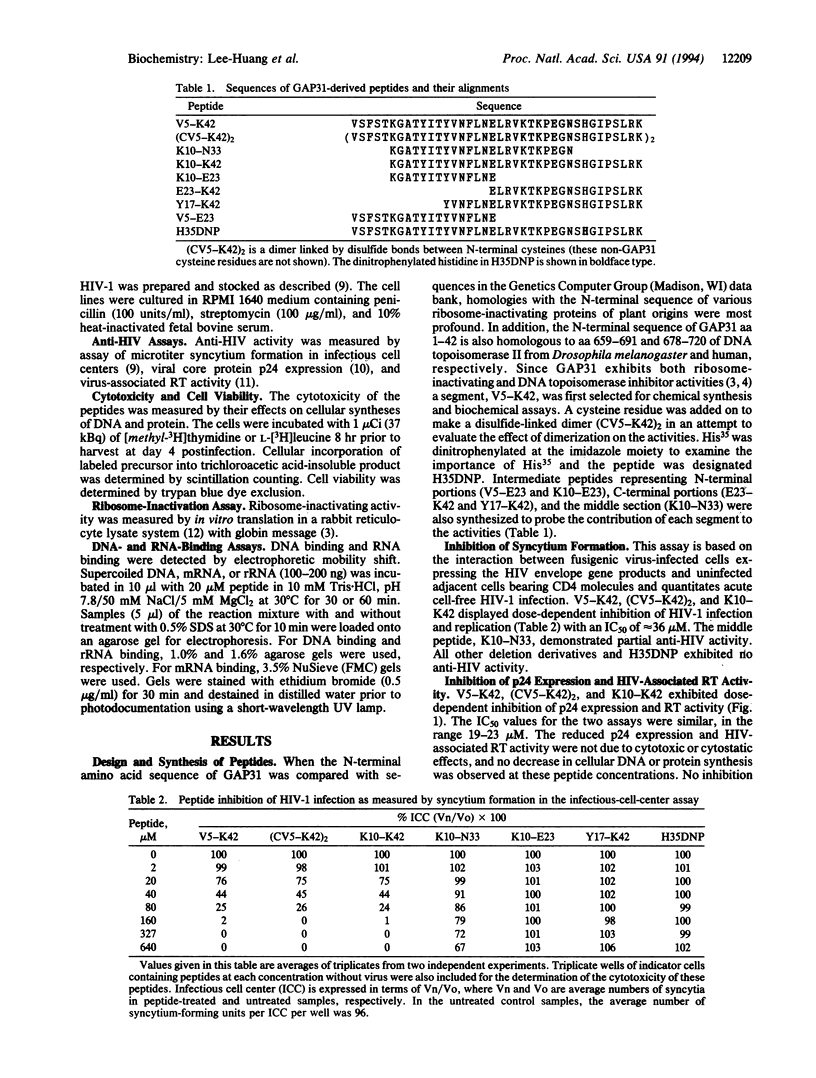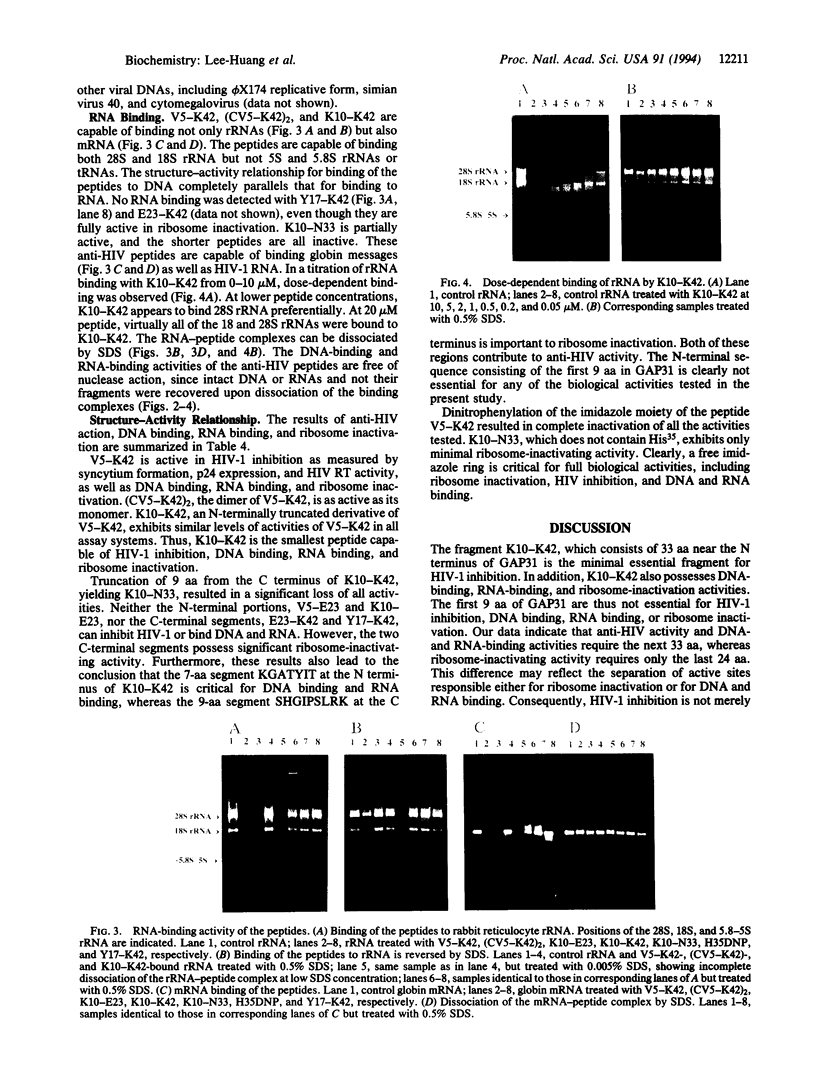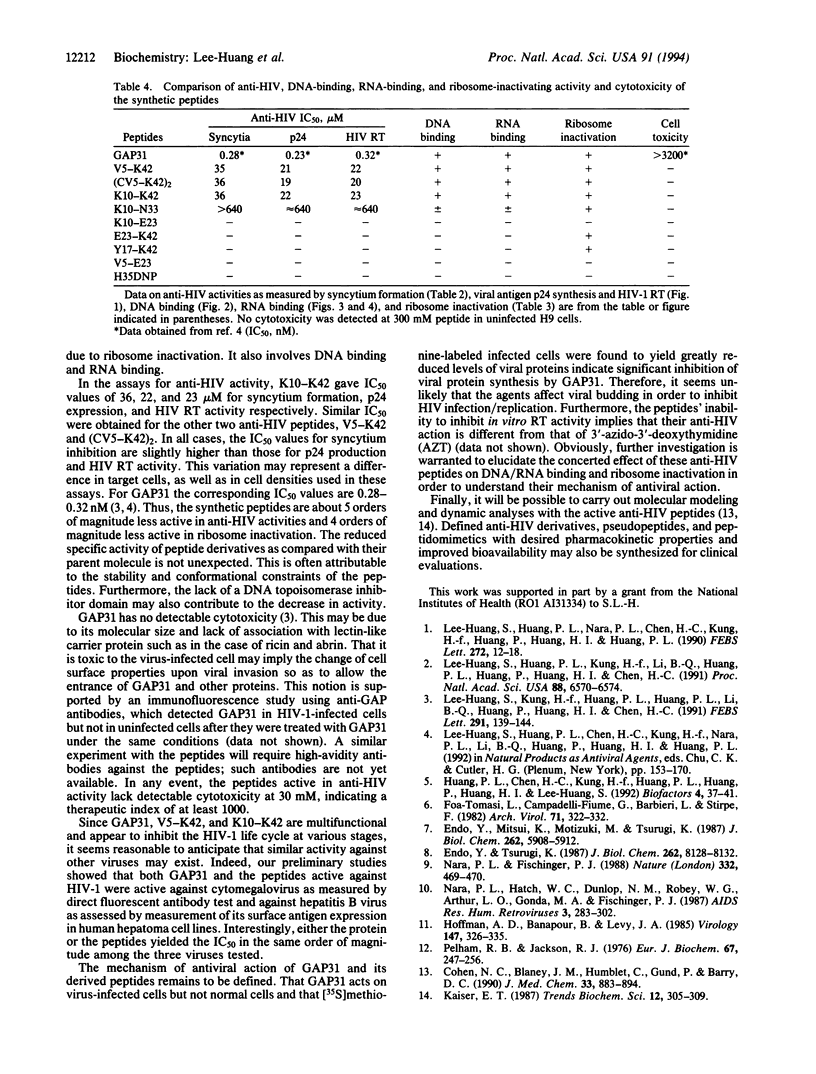Abstract
GAP31 (gelonium anti-HIV protein of 31 kDa) is an anti-HIV protein which we have identified and purified from a medicinal plant, Gelonium multiflorum. It is capable of inhibiting HIV-1 infection and replication. GAP31 also exhibits DNA topoisomerase inhibitor activity and RNA N-glycosidase activity. The ability of GAP31 to interrupt both DNA and RNA functions may be related to its multiple antiviral actions. To define the roles of these activities in the anti-HIV action of GAP31, a series of peptides corresponding to the N-terminal segment of GAP31 were synthesized and assayed for the aforementioned activities of the parent molecule. A 33-aa segment (KGATYITYVNFLNELRVKTKPEGNSHGIPSLRK) designated as K10-K42 is the shortest peptide necessary and sufficient for HIV-1 inhibition, DNA and RNA binding, and ribosome inactivation. The peptides were 2-5 orders of magnitude less active than GAP31. Truncation of 19 aa from the C terminus of K10-K42 resulted in the loss of all of these activities. On the other hand, deletion of N-terminal residues to give E23-K42 did not alter ribosome-inactivation activity but eliminated the other activities. These findings permit identification of a 7-aa sequence, KGATYIT, at the N terminus of K10-K42 that is critical for DNA binding and RNA binding, whereas a 9-aa sequence, SHGIPSLRK, at the C terminus is important to ribosome inactivation. Both regions contribute to anti-HIV activity. Histidine at position 35 is critical for all of these activities. The disparity of sequence requirements for inhibition of HIV infection and replication and for ribosome-inactivation activity suggests that the anti-HIV activity of most ribosome-inactivating proteins may not be the result of N-glycosidase activity alone. Mapping the minimal domain of GAP31 offers insights into the rational design of molecular mimetics of anti-HIV drugs.
Full text
PDF




Images in this article
Selected References
These references are in PubMed. This may not be the complete list of references from this article.
- Cohen N. C., Blaney J. M., Humblet C., Gund P., Barry D. C. Molecular modeling software and methods for medicinal chemistry. J Med Chem. 1990 Mar;33(3):883–894. doi: 10.1021/jm00165a001. [DOI] [PubMed] [Google Scholar]
- Endo Y., Mitsui K., Motizuki M., Tsurugi K. The mechanism of action of ricin and related toxic lectins on eukaryotic ribosomes. The site and the characteristics of the modification in 28 S ribosomal RNA caused by the toxins. J Biol Chem. 1987 Apr 25;262(12):5908–5912. [PubMed] [Google Scholar]
- Endo Y., Tsurugi K. RNA N-glycosidase activity of ricin A-chain. Mechanism of action of the toxic lectin ricin on eukaryotic ribosomes. J Biol Chem. 1987 Jun 15;262(17):8128–8130. [PubMed] [Google Scholar]
- Foà-Tomasi L., Campadelli-Fiume G., Barbieri L., Stirpe F. Effect of ribosome-inactivating proteins on virus-infected cells. Inhibition of virus multiplication and of protein synthesis. Arch Virol. 1982;71(4):323–332. doi: 10.1007/BF01315062. [DOI] [PubMed] [Google Scholar]
- Hoffman A. D., Banapour B., Levy J. A. Characterization of the AIDS-associated retrovirus reverse transcriptase and optimal conditions for its detection in virions. Virology. 1985 Dec;147(2):326–335. doi: 10.1016/0042-6822(85)90135-7. [DOI] [PubMed] [Google Scholar]
- Huang P. L., Chen H. C., Kung H. F., Huang P. L., Huang P., Huang H. I., Lee-Huang S. Anti-HIV plant proteins catalyze topological changes of DNA into inactive forms. Biofactors. 1992 Dec;4(1):37–41. [PubMed] [Google Scholar]
- Lee-Huang S., Huang P. L., Kung H. F., Li B. Q., Huang P. L., Huang P., Huang H. I., Chen H. C. TAP 29: an anti-human immunodeficiency virus protein from Trichosanthes kirilowii that is nontoxic to intact cells. Proc Natl Acad Sci U S A. 1991 Aug 1;88(15):6570–6574. doi: 10.1073/pnas.88.15.6570. [DOI] [PMC free article] [PubMed] [Google Scholar]
- Lee-Huang S., Huang P. L., Nara P. L., Chen H. C., Kung H. F., Huang P., Huang H. I., Huang P. L. MAP 30: a new inhibitor of HIV-1 infection and replication. FEBS Lett. 1990 Oct 15;272(1-2):12–18. doi: 10.1016/0014-5793(90)80438-o. [DOI] [PubMed] [Google Scholar]
- Lee-Huang S., Kung H. F., Huang P. L., Huang P. L., Li B. Q., Huang P., Huang H. I., Chen H. C. A new class of anti-HIV agents: GAP31, DAPs 30 and 32. FEBS Lett. 1991 Oct 7;291(1):139–144. doi: 10.1016/0014-5793(91)81122-o. [DOI] [PubMed] [Google Scholar]
- Nara P. L., Fischinger P. J. Quantitative infectivity assay for HIV-1 and-2. Nature. 1988 Mar 31;332(6163):469–470. doi: 10.1038/332469a0. [DOI] [PubMed] [Google Scholar]
- Nara P. L., Hatch W. C., Dunlop N. M., Robey W. G., Arthur L. O., Gonda M. A., Fischinger P. J. Simple, rapid, quantitative, syncytium-forming microassay for the detection of human immunodeficiency virus neutralizing antibody. AIDS Res Hum Retroviruses. 1987 Fall;3(3):283–302. doi: 10.1089/aid.1987.3.283. [DOI] [PubMed] [Google Scholar]
- Pelham H. R., Jackson R. J. An efficient mRNA-dependent translation system from reticulocyte lysates. Eur J Biochem. 1976 Aug 1;67(1):247–256. doi: 10.1111/j.1432-1033.1976.tb10656.x. [DOI] [PubMed] [Google Scholar]





